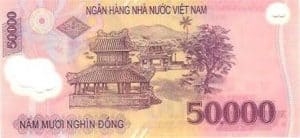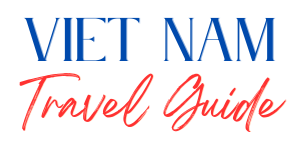What currency (money) you should use when visiting a particular country is one of the most important topics travelers should research before visiting, because you won’t get too far without knowing the currency. What is the most commonly accepted currency?
As a general rule, it’s best to use your local currency when you’re traveling as it’s accepted almost everywhere. However, in countries where the local currency is depreciating extremely rapidly (e.g. Venezuela, Argentina), you really don’t want to be caught holding a depreciating currency every day. Also, many shops and restaurants in the developing world do not accept credit or debit cards, so sometimes cash is the only option.
So what is the currency story in Vietnam? Hopefully, our blog post will remove most of the confusion about which currency to use in Vietnam, as well as the misunderstanding that often occurs with the subject of money in Vietnam.
How to pay when buying goods in Vietnam?
The official currency of Vietnam is Dong (VND). There is nothing that cannot be bought in Vietnam with VND. It is worth mentioning that in Vietnam, it is illegal to request payment in any currency other than Dong. If that’s the case, you might ask why are prices at the market when you buy souvenirs in Vietnam (eg accommodation and tours), listed in US dollars (USD)? The main reason is for comparison, as few people understand how the Vietnamese Dong compares to their own currency. While most people will understand how their currency compares to USD. For reference, as of May 2023, 1 US dollar is worth about 23,400 VND.
Now, the big question! Can I pay for things in Vietnam in USD? Yes, it is widely accepted by many hotels, shops and restaurants.
Now, the second part of the big question! Should I pay in USD while in Vietnam? While you can, there is a downside to doing so. The exchange rate will be the one set by the supplier, which is more likely to benefit them than yours. As such, whatever you’re buying, it’s likely to cost you more than it should. Now that we know that we need Dong to survive in Vietnam, how do we get it?
The saying ‘Cash is king’ is certainly true in Vietnam. And because everything there is relatively cheap, compared to ‘home’, it is not difficult to transact in cash only.
How to change your home currency in Vietnam
First of all, it is important to mention that you will get a much better rate when exchanging money in Vietnam, as opposed to exchanging in your own country. So unless you want to give money away, you should wait until you arrive. Many currencies from around the world are widely accepted for exchange, including US dollars, British Pounds, Euros and Australian dollars.
When it comes to currency exchange, you have a few options:
Banks and forex businesses are the main places, but surprisingly some of the best places to exchange money are gold/jewelry stores. Banks have more formal procedures, which means you’ll need to show your passport as well as fill out forms. You may also have to wait in line for a while if there are many customers at the bank. Forex shops are very simple whereby you hand over your money and instantly receive the equivalent amount in VND. Changing money at gold shops, although technically illegal, is also very simple. No forms are required and no passport is required; again, it’s a straight exchange. If you’re in a small town and can’t find a money changer or gold shop, many travel agents will also offer currency exchange.
Interestingly, even the currency exchange booths at the airport are very competitive in terms of rates when compared to the money changers and gold shops scattered throughout the cities. So it’s all very simple, but is there anything else you need to keep in mind before exchanging your hard-earned currency for a handful of Dong?
Ensure the following things when exchanging money in Vietnam
- Get an idea of the current exchange rate for the currency you’re about to change.
- You can do this by downloading one of the many currency apps found on most smartphones, or even simply having a shortcut link to a currency exchange website on your phone. The latest exchange rate of the app or website (check our real time VND rate table), will not be exactly what you will be given. However, it will give you an idea of what the rate is and what you are offered should be relatively close to that. If not, go out and try somewhere else.
- Check that the notes you are going to exchange are in good condition. Torn and damaged bills may not be accepted, and even bills that have been written on them can be a problem.
- Make sure you are given a variety of VND coins, including some of the lower denominations. ‘Breaking’ the VND 500,000 bill can be a problem when buying cheap items, so having a variety of coins including the 20,000, 50,000 and 100,000 VND bills will make life much easier.
- Count the money you receive in front of the person you are exchanging before leaving the store.
- Do not exchange too much money in one transaction. Chances are, the Dong you receive will take up more room in your wallet than your own currency.
- Back to Content
Use ATM to withdraw money in Vietnam

So not interested in exchanging currency, or not comfortable carrying around a lot of cash? Or perhaps you just want another option? ATM is your answer, then.
ATMs are everywhere in Vietnam. Overall, you won’t have to walk too far in most cities to find it. However, like currency exchange, there are a few things you need to know about Vietnamese ATMs.
- ATMs in Vietnam only withdraw Vietnamese Dong.
- All ATMs have different withdrawal limits per transaction.
- Limits vary from machine to machine, from bank to bank, and can range from 2,000,000 to about 10,000,000 VND, with most being on the lower end of that range.
- Please note that there is an ATM fee for each withdrawal. This fee varies from bank to bank, but usually ranges from VND 20,000 to VND 50,000 per transaction.
- As of 2019, good banks only charge from 30,000-55,000 VND for a single withdrawal. If the ATM asks for more, it’s best to keep walking.
What about the ‘hidden’ fees your own bank would annoy you in international transactions? These fees can really make ATM fees look like small changes. And if you are using low limit machine; need to withdraw several times to get the amount you requested, you may get a rude shock when you check your bank statement when you get home. These fees will vary from bank to bank, but you might consider a fee of around $5 per transaction. This number may not sound like much, but it quickly adds up if you have a withdrawal restriction of around $100. So, if you are going to use an ATM in Vietnam, try to apply for a card from a bank that does not charge extra fees for international withdrawals.
How to use credit cards in Vietnam

Visa and Mastercard credit cards
Although the number of businesses in Vietnam that accept credit cards has increased significantly in recent years, apart from major Vietnamese hotels, a number of tour operators, large supermarkets and some restaurants Most businesses in Vietnam still do not accept credit cards. Even for businesses that accept credit cards, be aware that some merchants will add a minimum surcharge of 3% to the purchase price in addition to the foreign transaction fee your credit card company charges. can calculate for you. As with the advice we gave about ATM cards, try signing up with a credit card provider that doesn’t charge international transaction fees before you travel. In summary, we only recommend using a credit card for large purchases where you can earn bonus points or in case of an emergency.
VIETNAM DONG – EXPRESSION
Vietnam’s banknotes have many different denominations, which are mainly polymer resins.
Plastic denominations include 10,000, 20,000, 50,000, 100,000, 200,000, and 500,000. To avoid common scams, pay attention to the following notes.
There are also some older banknotes and they come in denominations of 1,000, 2,000 and 5,000 yen
HOW PLASTIC MONEY LOOK


500,000 VND = 21.367 US dollars (May 2023)










As you can see, there are a lot of zeros. And that can be a bit confusing to begin with. Adding to the confusion is that some bills are similar in color, so make sure you know which bills you’re transferring, as well as any bills you’re receiving.
PAPERS OF LOWER VALUE



You will receive lower denomination bills quite often as change, and although they are very low value, they add up when you have a lot. These smaller bills can come in very handy for cheap items like bottled water, street snacks, or even for your motorbike taxi.
Here is my VND wallet suggestion
While VND 500,000 bills are great for larger purchases, like accommodation and payments for travel, they are not ideal for everyday purchases like drinks, food, souvenirs and even taxi fares. Many everyday things you can afford to buy will be less than 100,000 VND, and if that is the case, giving a 500,000 VND bill to buy 50,000 VND can be problematic when receiving change. Always try to keep a few 20,000, 50,000 and 100,000 VND bills in your wallet or purse to buy smaller things. And if you find yourself running out of money with those denominations, look for an opportunity to ‘break’ the 500,000 VND bill. Those convenience stores mentioned earlier can be helpful for that.
So, with a little understanding of your options when it comes to money, hopefully now you will have enough confidence to go out and really enjoy Vietnam.
